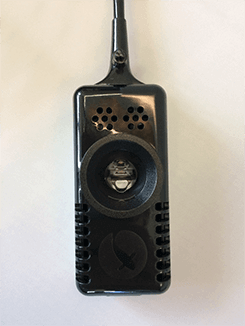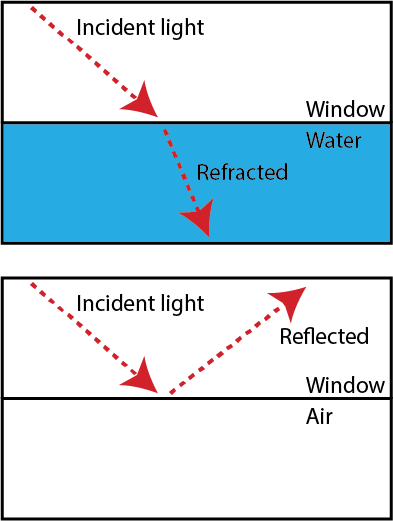Out of Water alerts
Table of contents
The seneye device uses an optical system to know if it is in or out of the water. This uses the round light window on the black side of the sensor:

The sensor flashes a red LED through this window. Depending on if this window is covered by air or by water – and therefore if the light is travelling into a more or less dense material – the light from the LED either travels through the window or is reflected back into the sensor. The top half of the diagram below shows how light travels through the window if it is covered by water, and the bottom half shows how it is reflected back if the window is covered by air:

The sensor can detect if the light that its LED shines bounces back, and so can therefore tell when it is out of water.
This method of testing allows the system to only take a measurement of temperature, pH and NH3 when it is actually in your aquarium or pond.
Your device will alert you to it being out of water by E-mail and SMS*. You can then position your seneye device where you would like an alert if the water level drops below. This could indicate that the tank is leaking, or that evaporation has reduced the water level.
Mounting the seneye device with the back facing into your aquarium will generally give the best results.
Repeated “Out of Water” alerts
The seneye device uses an optical system on the back of the device to establish if the device is in or out of water. The red light on the back of the device flashes when an in/out of water reading is being taken. If the device is "out of water" then the four lights on the front of the device will flash.
Whilst the in/out of water test is usually very reliable, there are certain circumstances where a false positive can occur, these are listed below:
- An air bubble on the light window; this is quite common in ponds using the float close to a filter outlet or a source of aeration.
- The black back of the seneye device is positioned against a surface that will reflect light back into the device, so please make sure the back of the device is facing into the body of water.
- If the device is reporting "Out of Water" at the same time each day this can be because the sunlight is hitting your pond at that time every day, therefore please try moving your device to a different position.
No “Out of Water” alerts
In addition to this, there is also the opposite scenario, where there is no "Out of Water" alert, even though the device is clearly out of water. This can be due to the following reasons:
- The tank you are using is in a very dimly lit environment. In this case, when the device gets pulled out of water the sensor does not pick up enough change in lighting to prompt the device to take a reading. If this is the case and you are merely trying to test whether the out of water alert functions, please hold the device under a brighter light source once removed from the water.
- Please also note that if there is only a slight shift in the brightness of the perceivable light, the device will not give an immediate response. The “Out of Water” reading will, however, appear with the next update on your readings.
- Algae or bacteria have covered the back window on the device and it needs cleaning.
If you have tried all of these suggestions and the device is still failing to report "Out of Water" or reports as "Out of Water" when it isn’t, please contact customer support via email on [email protected] from the email address your account is registered to.
*Provided that your mobile number is registered and you have a valid slide.